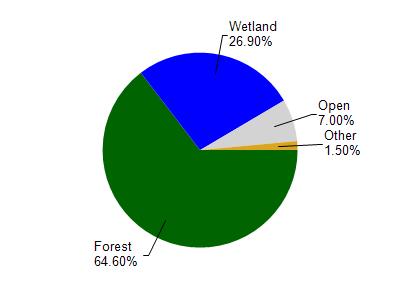Oneida
No
No
Yes
Fish and Aquatic Life
Overview
Little Bearskin Lake, in the Middle Tomahawk River Watershed, is a 184.08 acre lake that falls in Oneida County. This lake is managed for fishing and swimming and is currently considered impaired.
Date 2016
Author Ashley Beranek
Historical Description
Source: 1966, Surface Water Resources of Oneida County Little Bearskin Lake T37N, R6E, Section 11 Surface Acres = 173.8, S.D.F. = 2.27, Maximum Depth = 23 feet.
A soft water drainage lake having slightly alkaline light brown water of moderate transparency. Muck is the principal littoral material (55 percent) with sand (25 percent) and some gravel, rubble and boulders present. The shoreline is predominantly upland (80 percent) with a bog and meadow wetland bordering a portion of the lake basin. Floating and submergent vegetation are dense in parts of the lake basin. Fish species found in this lake are muskellunge, northern pike, walleye, largemouth bass perch, bluegill, crappie, pumpkinseeds and bullheads. Public access with parking is available. Two resorts and three dwellings are located on the shoreline. Black duck use this lake as a nesting site. Puddle ducks and diving ducks utilize this lake on their fall migration. At the time of survey an active beaver dam was located on the outlet.
Date 1966
Author Surface Water Inventory Of Wisconsin
Impaired Waters
Little Bearskin Lake was evaluated for phosphorus and algae every two years from 2014 to 2022. Phosphorus levels were found to be too high for healthy plant, bug, and fish communities. This lake was listed for phosphorus in 2016.
Date 2022
Author Ashley Beranek
Condition
Wisconsin has over 84,000 miles of streams, 15,000 lakes and milllions of acres of wetlands. Assessing the condition of this vast amount of water is challenging. The state's water monitoring program uses a media-based, cross-program approach to analyze water condition. An updated monitoring strategy (2015-2020) is now available. Compliance with Clean Water Act fishable, swimmable standards are located in the Executive Summary of Water Condition in 2018. See also the 'monitoring and projects' tab.
Reports
Recommendations
Lake Management Plan Development
Informational Meetings
Develop/Distribute Newsletter
Shoreland Monitoring, Assessment, Inventory
Shoreland Monitoring, Assessment or Inventory
Monitor Water Quality or Sediment
This determination is based on one year (2017) with higher than average chlorophyll for the lake. This is not clear in any other year between 2009 and 2018.
Management Goals
Wisconsin's Water Quality Standards provide qualitative and quantitative goals for waters that are protective of Fishable, Swimmable conditions [Learn more]. Waters that do not meet water quality standards are considered impaired and restoration actions are planned and carried out until the water is once again fishable and swimmable
Management goals can include creation or implementation of a Total Maximum Daily Load analysis, a Nine Key Element Plan, or other restoration work, education and outreach and more. If specific recommendations exist for this water, they will be displayed below online.
Monitoring
Monitoring the condition of a river, stream, or lake includes gathering physical, chemical, biological, and habitat data. Comprehensive studies often gather all these parameters in great detail, while lighter assessment events will involve sampling physical, chemical and biological data such as macroinvertebrates. Aquatic macroinvertebrates and fish communities integrate watershed or catchment condition, providing great insight into overall ecosystem health. Chemical and habitat parameters tell researchers more about human induced problems including contaminated runoff, point source dischargers, or habitat issues that foster or limit the potential of aquatic communities to thrive in a given area. Wisconsin's Water Monitoring Strategy was recenty updated.
Grants and Management Projects
Monitoring Projects
| WBIC | Official Waterbody Name | Station ID | Station Name | Earliest Fieldwork Date | Latest Fieldwork Date | View Station | View Data |
|---|
| 1523500 | Little Bearskin Lake | 10004455 | Little Bearskin Lake | 7/27/1999 | 6/21/2018 | Map | Data |
| 1523500 | Little Bearskin Lake | 10018916 | Little Bearskin Lake -- Access | 7/12/2008 | 7/28/2020 | Map | Data |
| 1523500 | Little Bearskin Lake | 444022 | Little Bearskin Lake - Little Bearskin Lake | 8/20/1979 | 8/20/1979 | Map | Data |
| 1523500 | Little Bearskin Lake | 443132 | Little Bearskin Lake - Deep Hole | 8/14/1973 | 9/7/2025 | Map | Data |
| 1523500 | Little Bearskin Lake | 10041913 | Little Bearskin Lake - Center | 6/30/2014 | 7/24/2018 | Map | Data |
|

Watershed Characteristics
Little Bearskin Lake is located in the Middle Tomahawk River watershed which is 233.30 mi². Land use in the watershed is primarily forest (64.60%), wetland (26.90%) and a mix of open (7%) and other uses (1.50%). This watershed has 191.49 stream miles, 4,575.90 lake acres and 42,061.39 wetland acres.
Nonpoint Source Characteristics
This watershed is ranked Not Ranked for runoff impacts on streams, Low for runoff impacts on lakes and Low for runoff impacts on groundwater and therefore has an overall rank of Low. This value can be used in ranking the watershed or individual waterbodies for grant funding under state and county programs.However, all waters are affected by diffuse pollutant sources regardless of initial water quality. Applications for specific runoff projects under state or county grant programs may be pursued. For more information, go to surface water program grants.